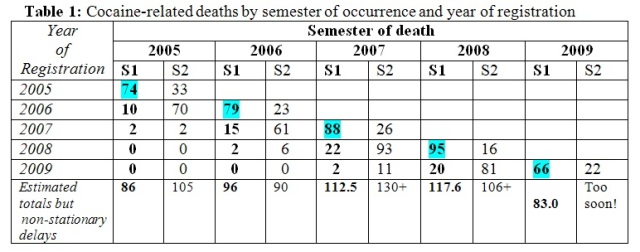Banned drug may have saved lives, not cost them
Deaths linked to cocaine and ecstasy fell significantly in the first half of 2009 – a surprising finding, since cocaine-related deaths had been steadily rising year by year.
One possible explanation might be that cocaine and ecstasy-users were switching to a less dangerous drug, mephedrone, in and before this period. Results of mandatory drug tests on soldiers showed a sharp drop in cocaine use during 2008, which continued into 2009.
I speculated here that this decline might be the result of soldiers’ shifting to mephedrone, then a “legal high”. If that were also true among the wider drug-using population, then the decision in April 2010 to make mephedrone illegal may have had the unintended consequence of reversing a notable decrease in cocaine-related deaths.
How large a decrease was there, and was it commensurate with the change in soldiers’ off-duty cocaine-use? Table 1 shows new information on cocaine-related deaths by semester of death and year of registration.
Concentrating only on cocaine-related deaths occurring in the first six months (semester, S1) of any year and registered in the same year – that is, 74 in S1 of 2005 rising to 95 in S1 of 2008 – notice that cocaine-related deaths increased by 20 per cent between the two-year period 2005+06 and the two-year period 2007+08 (p < 0.10), only to decrease significantly by 28 per cent between the latter period (where the mean was (88+95)/2 = 91.5) and the first semester of 2009 (66), p < 0.01. (See figures highlighted in table.)
Extrapolating, the difference between observed and expected cocaine-related deaths for 2009 could amount to 50 fewer cocaine-related deaths.
This decrease in cocaine-related deaths in the first semester of 2009 matches the 30 per cent decrease in British soldiers’ cocaine positive rate in compulsory drugs tests (CDTs) from 5.2 per 1,000 CDTs in the first three-quarters of 2008 (95 per cent CI: 4.7 to 5.8) to 3.5 per 1,000 CDTs in the October to December quarter (CI: 2.8 to 4.2). A further decrease in soldiers’ cocaine positive rate in CDTs occurred in 2009, see previous Straight Statistics articles here and here.
It is too early to draw any definite conclusions. Thanks to registration delays we do not yet know how many cocaine-related deaths occurred in the second half of 2009. The question is: will the 28 per cent decrease in cocaine-related deaths in the first half of 2009 be reinforced in the second half of 2009, corroborated internationally, and not matched by an increase in mephedrone-related deaths?
If all these conditions were to apply, then the decision to make mephedrone illegal may have curtailed a notable decrease in deaths. And so closed off a pragmatic harm-reduction strategy – that of switching from illegal cocaine with its documented lethality to a legal high which avoided criminality and the criminals who deal drugs, and which might (or might not) have lower lethality than cocaine.
When the Advisory Council on Misuse of Drugs (ACMD) formulated its advice to Ministers, the decrease in cocaine deaths in the first semester of 2009 was not yet evident. Why? Because, as Straight Statistics has reported, the coronial system in England does not need to register a death until a cause has been identified. Drug-related deaths normally require a coroner’s inquest, and the delays in carrying out these inquests may be getting longer. And so, timely information on any change in the numbers of such deaths is lacking.
But, based on the evidence that soldiers were switching away from cocaine and Ecstasy, Straight Statistics specifically raised the possibility of decreased cocaine or Ecstasy deaths if this shift were to apply to young people generally.
Interestingly, ecstasy deaths have also fallen. For England and Wales, by year of registration, ecstasy-only deaths (defined as: ecstasy present but no heroin, no methadone, no cocaine, no benzodiazepines) reduced from138 in 2004-2007 (34.5 per annum) to 36 in 2008+2009 (18 per annum).

PS: Cocaine-only deaths (that is: cocaine present but no heroin, no methadone, & no benzodiazepines) in the first semester (S1) of 2005 to 2009 and registered in the same year were: 21, 26 (mean of 23.5); 36, 32 (mean of 34); 18.




http://neurobonkers.com (not verified) wrote,
Sat, 04/12/2010 - 21:10
The panic that surrounded "meow" "meow" through 2009 as almost as ridiculous as the digital drugs scare in the US... http://neurobonkers.com/?p=299